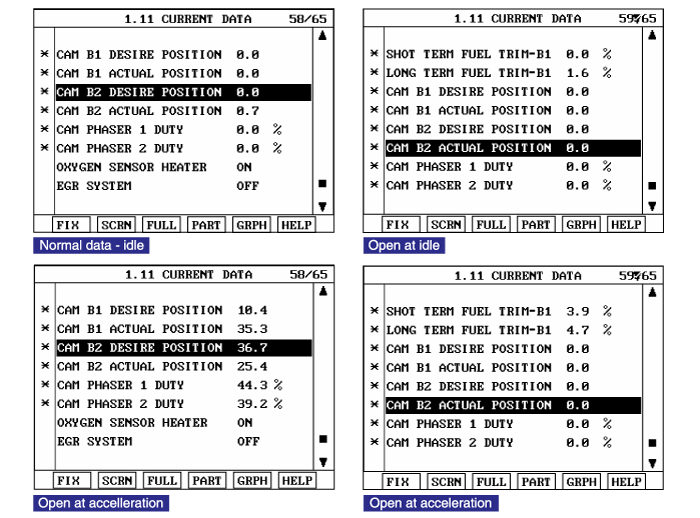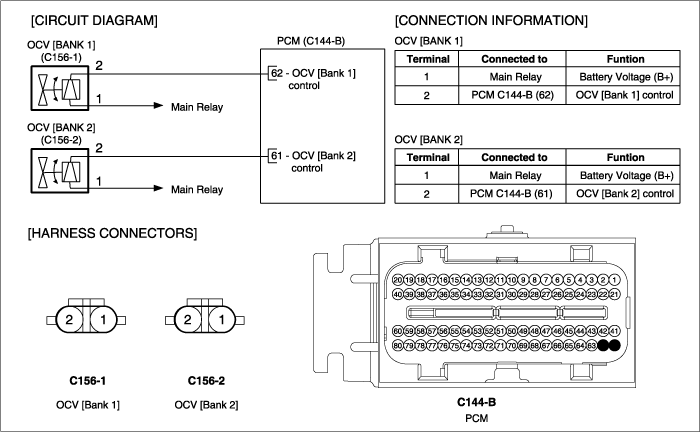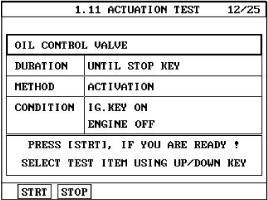Monitor "CMPS(B2)" on the service data.


Different from the existing fixed cam phase angle type, CVVT(Continuously Variable Valve Timing) is the device which varies cam phase angle continuously to be optimum. And with engine oil pressure, it operates. CVVT consists of OCV(Oil Control Valve) and cam phaser. OCV, mounted on cylinder head, controlls the amount and direction of oil delivered to cam phaser by oil valve which is connected to a solenoid. Cam phaser, rotating cam phaser rotor with pressure and amount of oil produced by OCV, rotates cam shaft forcefully for or against the rotating direction and finally, cam shaft phase changes. With the appliance of CVVT, engine power,fuel efficiency and the quality of exhause gas are improved.
PCM detects CAM phasing average rate while cam offset is available. If the CAM phasing rate is failure in 12 times out of 15 CAM phasing test PCM determines that a fault exists and a DTC is stored.
Item | Detecting Condition | Possible cause | |||||
DTC Strategy | ● Determines if the phaser is moving at an expected rate | ● Excessive phasing system leakage ● Insufficient Oil Pressure (ex. Blockage in OCV filter) ● Faulty PCM | |||||
Enable Conditions | ● Cam Offset is available | ||||||
Threshold value | ● Cam phasing average rate is out of threshold programmed in PCM | ||||||
Diagnosis Time | ● Continuous (12 tests failure for 15 cam edge tests) | ||||||
MIL On Condition | ● 2 driving cycles | ||||||


connect scantool and ENG "ON"
Monitor "CMPS(B2)" on the service data.

Are the "CMPS(B2)" data displayed correctly ?

▶ Fault is intermittent caused by poor contact in the sensor’s and/or PCM’s connector or was repairedand PCM memory was not cleared. Thoroughly check connectors for looseness, poor connection,bending, corrosion, contamination, deterioration, or damage. Repair or replace as necessary and goto "Verification of Vehicle Repair" procedure.

▶ Go to "System Inspection" procedure.
Visual Inspection
Check oil level is O.K.
Check oil is contaminated.
Check that any oil leakage or blockage is occurred on the parts related to CVVT.
Has a problem been found ?

▶ Repair or replace as necessary and then, go to " Verification of Vehicle Repair" procedure.

▶ Go to "Component Inspection" procedure.
Check OCV
Connect scantool and IG "ON"
Select "OCV" on the Actuation Test
Activate "OCV" by pressing "STRT(F1)" key
(should hear a faint click from Oil Control solenoid Valve)
Repeat this procedure 4 or 5 times to ensure reliability

Has a problem been found ?

▶ Substitute with a known - good OCV and check for proper operation. If the problem is corrected, replace OCV and go to "Verification of Vehicle Repair" procedure.

▶ Substitute with a known - good CVVT and check for proper operation. If the problem is corrected, replace CVVT and go to "Verification of Vehicle Repair" procedure.
After a repair, it is essential to verify that the fault has been corrected.
Monitor and record the Freeze Frame Data for the Diagnostic Trouble Code(DTC) which has been diagnosed.
Using a Scantool, Clear the DTCs
Operate the vehicle within conditions noted in the freeze frame data or enable conditions
Monitor that all rediness test have been verified as " Complete "
Are any DTCs present ?

▶ Go to the applicable troubleshoooting procedure.

▶ System is performing to specification at this time.